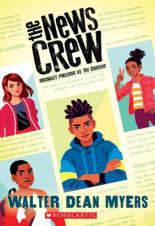May 3 is World Press Freedom Day, which celebrates the importance of a free press in a functional society. First organized by the United Nations General Assembly in 1993, it’s a day to commemorate journalists around the world who have fought with integrity for a free press.
Here at The Mixed-Up Files, we’d like to celebrate by shining a light on middle-grade books about real and fictional investigative journalists. If you have your own favorite middle-grade book about a star reporter, tell us about it in the comment section!
 The News Crew, (Book 1: Originally The Cruisers) by Walter Dean Myers
The News Crew, (Book 1: Originally The Cruisers) by Walter Dean Myers
 Isabel Feeney, Star Reporter by Beth Fantaskey
Isabel Feeney, Star Reporter by Beth Fantaskey
It’s 1920s Chicago—the guns-and-gangster era of Al Capone—and it’s unusual for a girl to be selling the Tribune on the street corner. But ten-year-old Isabel Feeney is unusual . . . unusually obsessed with being a news reporter. She can’t believe her luck when she stumbles into a real-life murder scene and her hero, the famous journalist Maude Collier. The story of how Isabel fights to defend the honor of her accused friend and latches on to the murder case makes for a winning middle grade mystery.
 The Tragically True Adventures of Kit Donovan by Patricia Bailey
The Tragically True Adventures of Kit Donovan by Patricia Bailey
Life in a Nevada mining town in 1905 is not easy for 13-year-old Kit Donovan, who is trying to do right by her deceased mother and become a proper lady. When Kit discovers Papa’s boss at the gold mine is profiting from unsafe working conditions, she realizes being a lady is tougher than it looks. With a man’s hat and a printing press, Kit puts her big mouth and all the life skills she’s learned from reading The Adventures of Huckleberry Finn to work, defying threats of violence and finding that justice doesn’t always look like she imagined it would.
 Adam Canfield of the Slash by Michael Winerip
Adam Canfield of the Slash by Michael Winerip
Adam Canfield has to be the most overprogrammed middle-school student in America. So when super-organized Jennifer coaxes him to be coeditor of their school newspaper, THE SLASH, he wonders if he’s made a big mistake. But when a third-grader’s article leads to a big scoop, Adam and his fellow junior journalists rise to the challenge of receiving their principal’s wrath to uncover some scandalous secrets. From a Pulitzer Prize-winning author and NEW YORK TIMES columnist comes a funny, inspiring debut that sneaks in some lessons on personal integrity — and captures the rush that’s connected to the breaking of a really great story.
 The Truth About the Truman School by Dori Hillestad Butler
The Truth About the Truman School by Dori Hillestad Butler
When Zebby and Amr create the website thetruthabouttruman.com, they want it to be honest. They want it to be about the real Truman Middle School, to say things that the school newspaper would never say, and to give everyone a chance to say what they want to say, too. But given the chance, some people will say anything—anything to hurt someone else. And when rumors about one popular student escalate to cruel new levels, it’s clear the truth about Truman School is more harrowing than anyone ever imagined.
 Clara Voyant by Rachelle Delaney
Clara Voyant by Rachelle Delaney
Clara can’t believe her no-nonsense grandmother has just up and moved to Florida, leaving Clara and her mother on their own for the first time. This means her mother can finally “follow her bliss,” which involves moving to a tiny apartment in Kensington Market, working at an herbal remedy shop and trying to develop her so-called mystical powers. Clara tries to make the best of a bad situation by joining the newspaper staff at her new middle school, where she can sharpen her investigative journalistic skills and tell the kind of hard-news stories her grandmother appreciated. But the editor relegates her to boring news stories and worse . . . the horoscopes.
Worse yet, her horoscopes come true, and soon everyone at school is talking about Clara Voyant, the talented fortune-teller. Clara is horrified — horoscopes and clairvoyance aren’t real, she insists, just like her grandmother always told her. But when a mystery unfolds at school, she finds herself in a strange situation: having an opportunity to prove herself as an investigative journalist . . . with the help of her own mystical powers.
 Ida B. Wells: Let the Truth Be Told by Walter Dean Myers, illus. Bonnie Christensen
Ida B. Wells: Let the Truth Be Told by Walter Dean Myers, illus. Bonnie Christensen
This picture book biography introduces the extraordinary Ida B. Wells. Long before boycotts, sit-ins, and freedom rides, Ida B. Wells was hard at work to better the lives of African Americans.
An activist, educator, writer, journalist, suffragette, and pioneering voice against the horror of lynching, she used fierce determination and the power of the pen to educate the world about the unequal treatment of blacks in the United States.
In this picture book biography, award-winning, New York Times bestselling author Walter Dean Myers tells the story of this legendary figure, which blends harmoniously with the historically detailed watercolor paintings of illustrator Bonnie Christensen.
 Nellie Bly and Investigative Journalism for Kids by Ellen Mahoney
Nellie Bly and Investigative Journalism for Kids by Ellen Mahoney








